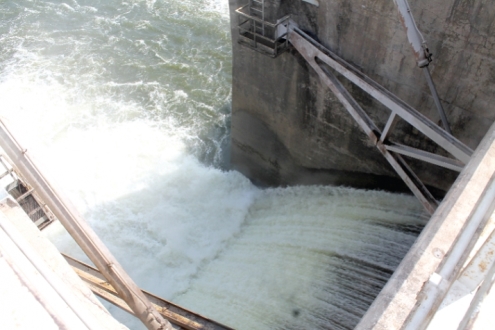The Ghana Water Company Limited (GWCL) has opened the Weija Dam in the Greater Accra Region to spill excess water to safeguard the dam from possible collapse.
The spillage that began on Wednesday morning was for the water level that was at 48 feet (14.6304) to reduce to 47 feet (14.3256), the maximum water operating level of the dam.
[contextly_sidebar id=”AKWPxwGpjNcq1OS5qBvj5bSuAcZNUEsR”]Following the opening of the spillways, managers of the dam indicated that the system was being controlled to avoid flooding in the nearby communities.
Situation under control
Therefore, the usual floods in the surrounding communities such as Tetegu, Oblogo, Pambros Salt, Lower McCarthy Hill, Weija, Bojo Beach and Ada Kopey, after spillage might not occur.
The Station Manager of the Weija Dam, Mr Paul Gandaa, told the Daily Graphic when a team visited the dam site that three out of the five spillways had been opened at six inch-level to ensure that the water ran smoothly.
When the Daily Graphic visited some residents in the nearby communities, they said they had been given notices. However, they said they would not move until they saw the water coming close to their neighbourhood.
“We have been here for five years and we face this situation all the time. This is no different from the other spillages we have experienced,” Mr Kwame Appiah, a resident, said.
“This is my home that I have built and I have my family here. I have no money to go and rent another place so I will stay here, if the water comes, I will move and come back again,” Mr John Darko, another resident, indicated.
“Be alert”
However, Mr Gandaa explained that if the water level continued to rise within 48 hours, then the situation would force management to open the five spill ways and increase the spillage speed, a situation that would cause flooding.
That, he indicated, would be necessary to prevent the water from collapsing the whole system, adding that currently notices had been sent to nearby residents to be on the alert.
Spillage from the Weija Dam is a normal exercise undertaken when necessary, especially during the rainy seasons, to allow the excess water to spill off.
Within a year, the dam could be spilled three to four times depending on the water level in the lake. The maximum water level the dam can contain is pegged at 47 feet.
Mr Gandaa further explained that when the rain from the Eastern part of the country was excessive, it caused the river to overflow its banks, hence the spillage to avoid the collapse of the system.
No funds for expansion
He said irrigation in the area was supposed to take 60 per cent of the water in the river, while the GWCL should take 30 per cent.
However, farming activities were limited, a development which has compelled the GWCL to spill the water.
When asked why the GWCL was not processing the excess water for distribution, Mr Gandaa said the company did not have enough funds to expand its systems for the process.
The Coordinator of the National Disaster Management Organisation (NADMO), Brigadier General Francis Vib Sanziri, who was at the dam to observe the situation, told the Daily Graphic that the situation was currently under control.
However, he warned that residents within the vicinity must be given short notice to vacate the area when need be.
He added that the staff of the NADMO had been positioned along the edges of the water to monitor the situation and report any unusual development.
Background
Construction of the Weija Dam began in 1974 and was completed in 1978 by an Italian company, Messrs Tahi. It is said to be the second urban water system to be constructed in Ghana, after Birimso in Cape Coast in the Central Region.
The Weija Lake has been formed over the Densu River in the Ga South municipality, which flows for about 116 kilometres from the Atiwa Mountains where it takes its source.
The river traverses three regions — Eastern, Central and Greater Accra, where it enters the sea at Bortianor in the Ga South municipality.
–
Source: Graphic Online


